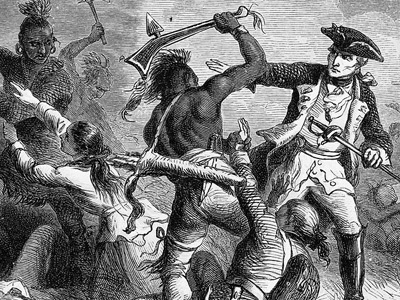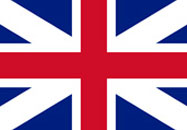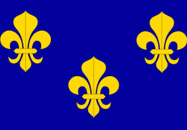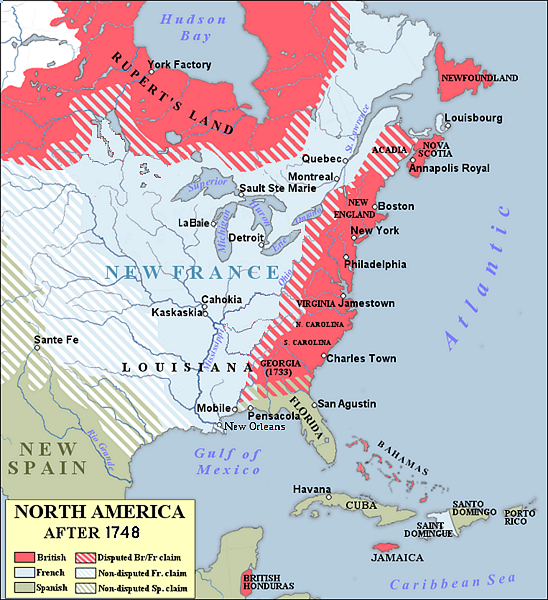French and Indian War (1754–1763)
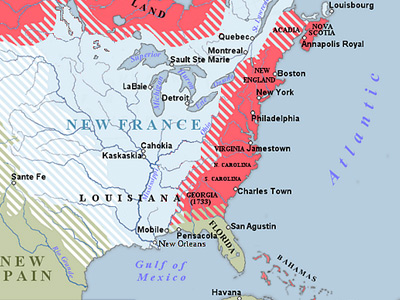
Course of the War
Even before Washington returned, Dinwiddie had sent a company of 40 men under William Trent to that point, where in the early months of 1754 they began construction of a small stockaded fort. Governor Duquesne sent additional French forces under Claude-Pierre Pecaudy de Contrecœur to relieve Saint-Pierre during the same period, and Contrecœur led 500 men south from Fort Venango on April 5, 1754. When these forces arrived at the fort on April 16, Contrecœur generously allowed Trent's small company to withdraw. He purchased their construction tools to continue building what became Fort Duquesne.

The earliest authenticated portrait of George Washington shows him wearing his colonel's uniform of the Virginia Regiment. This portrait was painted in 1772 by Charles Willson Peale.
After Washington had returned to Williamsburg, Dinwiddie ordered him to lead a larger force to assist Trent in his work. While en route, Washington learned of Trent's retreat. Since Tanaghrisson had promised support to the British The Kingdom of Great Britain was a sovereign country in Western Europe from 1 May 1707 to the end of 31 December 1800. The state was created by the 1706 Treaty of Union and ratified by the Acts of Union 1707, which united the kingdoms of England (which included Wales) and Scotland to form a single kingdom encompassing the whole island of Great Britain and its outlying islands, with the exception of the Isle of Man and the Channel Islands., Washington continued toward Fort Duquesne and met with the Mingo leader. Learning of a French scouting party in the area, Washington, with Tanaghrisson and his party, surprised the Canadians on May 28 in what became known as the Battle of Jumonville Glen. They killed many of the Canadians, including their commanding officer, Joseph Coulon de Jumonville, whose head was reportedly split open by Tanaghrisson with a tomahawk. The historian Fred Anderson suggests that Tanaghrisson was acting to gain the support of the British and regain authority over his own people. They had been inclined to support the French, with whom they had long trading relationships. One of Tanaghrisson's men told Contrecoeur that Jumonville had been killed by British musket fire.
The Kingdom of Great Britain was a sovereign country in Western Europe from 1 May 1707 to the end of 31 December 1800. The state was created by the 1706 Treaty of Union and ratified by the Acts of Union 1707, which united the kingdoms of England (which included Wales) and Scotland to form a single kingdom encompassing the whole island of Great Britain and its outlying islands, with the exception of the Isle of Man and the Channel Islands., Washington continued toward Fort Duquesne and met with the Mingo leader. Learning of a French scouting party in the area, Washington, with Tanaghrisson and his party, surprised the Canadians on May 28 in what became known as the Battle of Jumonville Glen. They killed many of the Canadians, including their commanding officer, Joseph Coulon de Jumonville, whose head was reportedly split open by Tanaghrisson with a tomahawk. The historian Fred Anderson suggests that Tanaghrisson was acting to gain the support of the British and regain authority over his own people. They had been inclined to support the French, with whom they had long trading relationships. One of Tanaghrisson's men told Contrecoeur that Jumonville had been killed by British musket fire.
Historians generally consider the Battle of Jumonville Glen as the opening battle of the French and Indian War in North America, and the start of hostilities in the Ohio valley.
Following the battle, Washington pulled back several miles and established Fort Necessity, which the Canadians attacked under the command of Jummonville's brother at the Battle of Fort Necessity on July 3. Washington surrendered; he negotiated a withdrawal under arms. One of Washington's men reported that the Canadian force was accompanied by Shawnee, Delaware, and Mingo native warriors—just those whom Tanaghrisson was seeking to influence.
News of the two battles reached England in August. After several months of negotiations, the government of the Duke of Newcastle decided to send an army expedition the following year to dislodge the French. They chose Major General Edward Braddock to lead the expedition. Word of the British military plans leaked to France The Kingdom of France is the historiographical name or umbrella term given to various political entities of France in the medieval and early modern period. It was one of the most powerful states in Europe since the High Middle Ages. It was also an early colonial power, with possessions around the world. Colonial conflicts with Great Britain led to the loss of much of its North American holdings by 1763. The Kingdom of France adopted a written constitution in 1791, but the Kingdom was abolished a year later and replaced with the First French Republic. well before Braddock's departure for North America. In response, King Louis XV dispatched six regiments to New France
The Kingdom of France is the historiographical name or umbrella term given to various political entities of France in the medieval and early modern period. It was one of the most powerful states in Europe since the High Middle Ages. It was also an early colonial power, with possessions around the world. Colonial conflicts with Great Britain led to the loss of much of its North American holdings by 1763. The Kingdom of France adopted a written constitution in 1791, but the Kingdom was abolished a year later and replaced with the First French Republic. well before Braddock's departure for North America. In response, King Louis XV dispatched six regiments to New France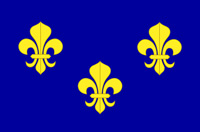 New France was the territory colonized by France in North America, beginning with the exploration of the Gulf of Saint Lawrence by Jacques Cartier in 1534 and ending with the cession of New France to Great Britain and Spain in 1763 under the Treaty of Paris. In the 16th century, the lands were used primarily to draw from the wealth of natural resources such as furs through trade with the various indigenous peoples. In the seventeenth century, successful settlements began in Acadia and in Quebec. under the command of Baron Dieskau in 1755. The British, intending to blockade French ports, sent out their fleet in February 1755, but the French fleet had already sailed. Admiral Edward Hawke detached a fast squadron to North America in an attempt to intercept the French.
New France was the territory colonized by France in North America, beginning with the exploration of the Gulf of Saint Lawrence by Jacques Cartier in 1534 and ending with the cession of New France to Great Britain and Spain in 1763 under the Treaty of Paris. In the 16th century, the lands were used primarily to draw from the wealth of natural resources such as furs through trade with the various indigenous peoples. In the seventeenth century, successful settlements began in Acadia and in Quebec. under the command of Baron Dieskau in 1755. The British, intending to blockade French ports, sent out their fleet in February 1755, but the French fleet had already sailed. Admiral Edward Hawke detached a fast squadron to North America in an attempt to intercept the French.
In a second British action, Admiral Edward Boscawen fired on the French ship Alcide on June 8, 1755, capturing her and two troop ships. The British harassed French shipping throughout 1755, seizing ships and capturing seamen. These actions contributed to the eventual formal declarations of war in spring 1756.
Albany Congress
An early important political response to the opening of hostilities was the convening of the Albany Congress in June and July, 1754. The goal of the congress was to formalize a unified front in trade and negotiations with various Indians, since allegiance of the various tribes and nations was seen to be pivotal in the success in the war that was unfolding. The plan that the delegates agreed to was never ratified by the colonial legislatures nor approved of by the crown. Nevertheless, the format of the congress and many specifics of the plan became the prototype for confederation during the War of Independence.
HISTORY
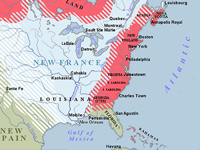
RESOURCES
This article uses material from the Wikipedia article "French and Indian War", which is released under the Creative Commons Attribution-Share-Alike License 3.0.
© Stories Preschool. All Rights Reserved.
